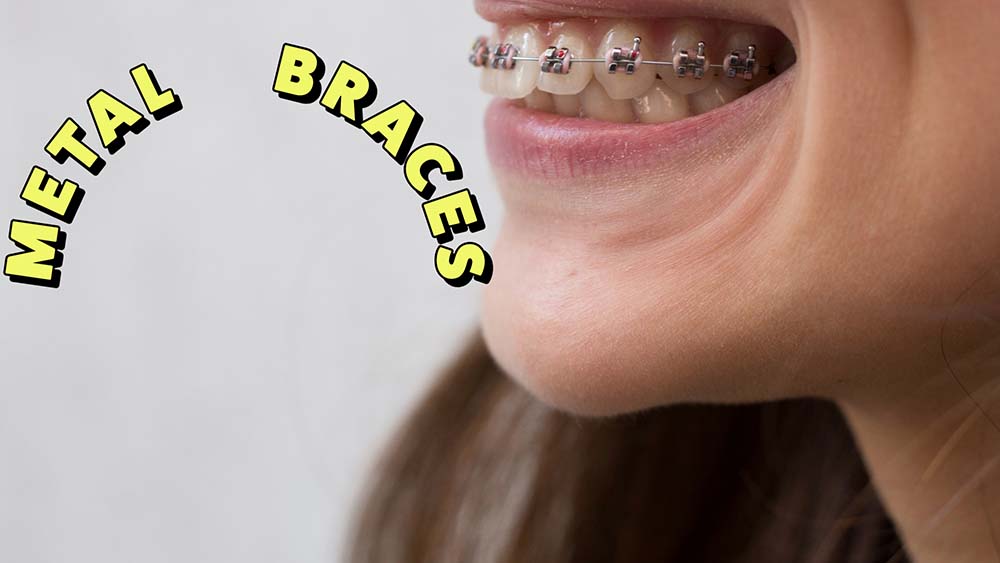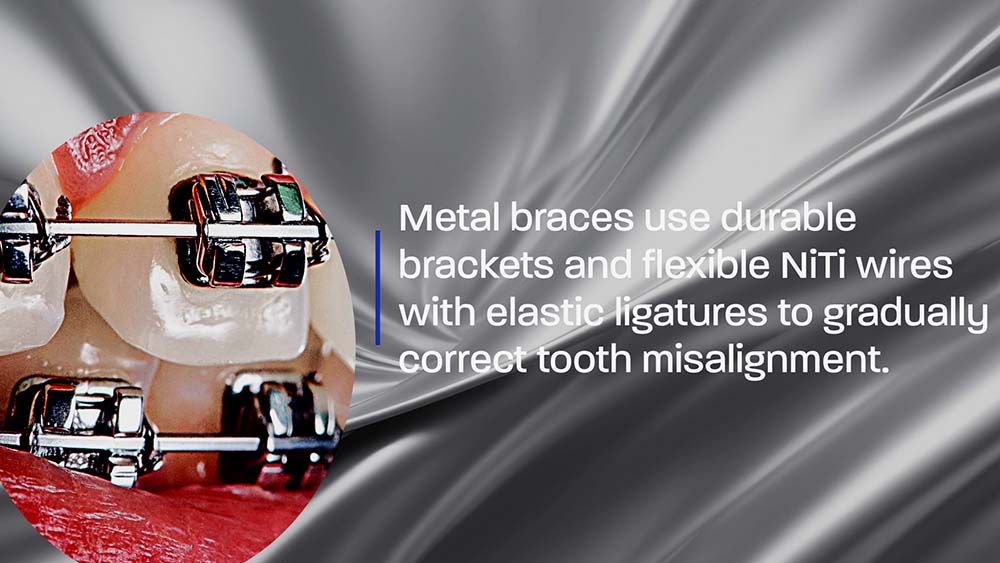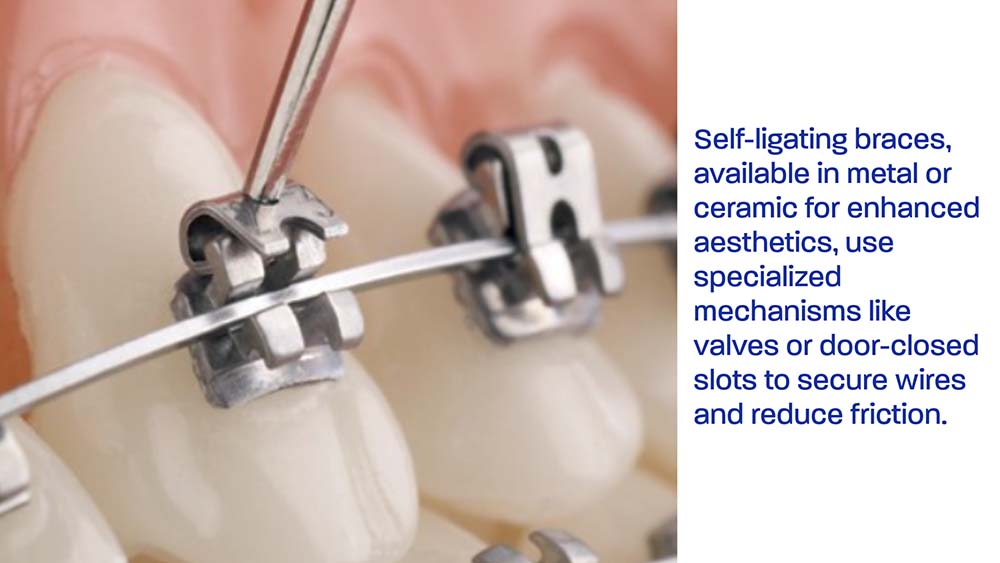Metal Braces.
Only for boundary-breakers .


Beyond the dentristy.
If you've ever lost a tooth or needed a replacement, you might have heard about Metal Braces.
They are a popular solution that not only looks and feels like your natural teeth but also offers long-term benefits. In this page, we’ll walk you through everything you need to know about Metal Braces in a simple and easy-to-understand way.
Metal Braces

Metal braces have been an orthodontic treatment option for adults and teenagers for over a century, and their reliability and long history of problem-free use make them a popular choice. Thanks to new, improved designs and long-lasting materials, this treatment is now even more effective at addressing issues like crowding, space constriction, and tooth gaps.
Here you will find detailed information about metal braces, including how they work, the materials used to make them, the various types, the pros and cons of each, and important details like treatment time and cost.

Metal braces are an effective orthodontic treatment to correct problems such as crowding, space narrowing or spacing. In this procedure, tiny brackets are cemented to the teeth and metal wires are threaded through them. The metal brackets are usually made of durable materials such as stainless steel and are fixed to the tooth surface with a special adhesive. In addition to traditional metal brackets, self-ligating brackets are also available; these brackets have valves or special mechanisms that hold the wires to minimize friction during treatment.
The wires used in the treatment are usually made of flexible and memory materials such as nickel titanium (NiTi). These wires allow the teeth to move towards the desired position thanks to the light and continuous force applied to the teeth. The attachment of the wires to the brackets is carried out by means of elastic modules or thin wires; thanks to the different color options of the elastic ligatures, it is also possible to provide an aesthetic touch during the treatment.The brackets used in metal braces are usually made of stainless steel, a material with a low coefficient of friction that helps teeth move more quickly and efficiently. The wires are mostly made of nickel titanium (NiTi) alloys. Thanks to their flexible structure and shape memory properties, these alloys resist applied forces while allowing the wires to easily return to their original shape.
In addition, some orthodontic braces are made of natalium, the same metal used in NASA's spacecraft. Thanks to the fact that natalium is a metal that can return to its original shape with the effect of heat, it contributes to the movement of the teeth in the desired direction by applying light and continuous force during the treatment process.
There are typically two varieties of metal braces.
Traditional metal braces.
In this type, the brackets are bonded over the teeth and the wires are attached to the brackets with elastic ligatures (rubber bands) or thin wires. In conventional metal brackets, small elastic modules (rubber bands) are used to fix the archwire to the bracket. The colors of these rubber ligatures can be changed. If it is Christmas time, you can choose red and green colors.
Self-ligating metal braces.

Self-ligating braces have valves or special mechanisms to hold the wires. This design reduces friction. Self-connecting brackets have a slot in which the wire is inserted and closed by a door. This design reduces friction. These brackets can be metal or ceramic. Ceramic ones offer a more aesthetic appearance.

Since metal braces are made of low-friction materials such as stainless steel, the treatment period is usually 6-8 months shorter than porcelain braces. Metal braces are the most advantageous alternative, especially when all teeth are required to move in the same motion. In addition, metal braces offer a budget-friendly option; that is, they are also advantageous in terms of cost.
Porcelain braces look much more natural and aesthetic than metal braces because they are very close to your tooth color. However, improper care can cause porcelain brackets to turn yellow and discolor over time due to exposure to tea, coffee, smoking, or colored foods. We should also add that porcelain brackets have a higher risk of breaking or rupturing because they are more delicate in material. So, if you wear porcelain braces, you may need to be a little more careful when eating or cleaning.
Invisalign braces, on the other hand, are almost invisible, as the name suggests; you can only spot them from a few meters away. Moreover, Invisalign braces provide a great advantage over metal and porcelain alternatives in moving a single tooth. When specific areas need to be treated, Invisalign braces can work much faster than alternatives.
Here are the advantages and disadvantages of metal braces:
Advantages:
- Speed: Metal brackets usually give faster results because they have a lower coefficient of friction. This allows the teeth to move faster.
- Affordability: Metal braces are more affordable than porcelain braces.
- Durability: Because metal braces are composed of a more resilient material, they are less prone to chip or shatter.
- No discoloration: Metal braces do not discolor and the metallic gray color will stay the same throughout your treatment.
- When using traditional metal braces, the colors of the rubber ligatures (colored rubber bands) attached to the brackets can be changed.
Disadvantages:
- Aesthetic Appearance: The appearance of metal brackets may be aesthetically problematic for some patients. The metallic appearance may not be suitable for people who care about their appearance, especially if they have a social position or occupation.
- Visibility: Metal braces have a metallic appearance and are more conspicuous.
- Difficulty cleaning: Because the surfaces of the teeth have metal, indentations and ridges that are not normally present, oral care is slightly different with braces and requires special brushing methods and materials. Eating and drinking rules should be followed, such as not eating anything hard, not drinking sugary or acidic drinks, not eating anything sticky, or cutting things up instead of biting them off.
Although the prices of metal braces vary depending on the region and clinic to be applied, you can take a look at the prices in different countries below.
| USA | $3,000 - $7,000 |
| England | £2,500 - £5,500 |
| Germany | €3,000 - €6,000 |
| Turkey | $1,500 - $3,500 |
| Hungary | €1,500 - €3,000 |
| Mexico | $1,500 - $3,500 |
| India | $1,000 - $3,000 |
Treatment with metal braces typically lasts between six months and three years at the very least. Typically, it takes around 18 months to treat a patient with moderate dental problems. The treatment time depends on how far the teeth are from the initial position to the final destination, i.e. how much work needs to be done. You can think of it like a cross-country trip; the time varies depending on where you are going from place to place.
Factors Affecting the Duration of Metal Braces Treatment:
- Patient cooperation: If you want the treatment to be short, do what your orthodontist says, wear the elastics and do not break the brackets.
- Teeth condition: The longer the treatment takes, the further off your teeth are from the start.
- Monthly check-ups: Following the initiation of orthodontic treatment, we conduct monthly check-ups to guide the teeth in the desired direction. In these checks, the wire can be thickened, a tighter wire can be worn, springs and elastics can be used. It is these monthly check-ups that advance the treatment and lead to the desired result.
- Correct positioning of the brackets: Correct positioning of the brackets is important. If the brackets are not in the correct position, the wires cannot move the teeth as desired.
After the treatment is finished, it is necessary to use retainers to keep the teeth in place and prevent them from returning to their original position. These retainers can be fixed wires or clear aligners that are bonded to the back surface of the teeth.
A typical treatment plan for metal braces will include the following steps.
Initial Examination and Diagnosis:
When you first visit an orthodontist, they will take a look at your teeth and gums to determine the best course of treatment for your unique needs. At this stage, the current position of your teeth and your desired result will determine how long the treatment will last. It is also very important that your teeth are clean and shiny before starting the treatment.
Fitting the brackets:
Then the brackets are individually bonded to your teeth using a special adhesive. This procedure is usually painless. The correct placement of the brackets is very important; for example, the line under the bracket should be parallel to the cutting edge of the tooth, and the line in the center of the bracket should be parallel to the root of the tooth. In order to place the brackets at the proper height—approximately 5 mm for central teeth and 4.5 mm for lateral teeth, for example—special measuring tools are utilized. To enhance adhesion, the dentist use acid to roughen the tooth surface and then rinses it well with water. After the adhesive is applied, any excess is removed, and the adhesive is hardened using blue light.
Braces and Fixation:
Once the brackets are in place, a wire, usually nickel titanium (NiTi), is threaded through the brackets to allow the teeth to move. Thanks to their flexible and memory structure, these wires are reshaped by body heat and apply a constant gentle force to the teeth. The brackets attach the wires to elastic ligatures (rubber bands that can change color) or thin wires. In self-ligating braces, the slot in which the wire is placed is fixed with valves or special mechanisms. In addition, the wire ends are carefully trimmed to prevent irritation to your cheek or lips.
Monthly Check-ups and Adjustments:
To make sure your teeth are moving in the right direction during treatment, you will have monthly checkups. During these appointments, the braces' thickness, the number of arcs and elastics used, or the tightness of the wires may be adjusted. Each time, there is also the chance to choose new colored elastics. To make sure the force is enough, the dentist checks the teeth and moves the brackets slightly if needed.
Things to be aware of during treatment:
It is important to pay extra attention to your oral care during treatment. Because of the brackets and wires on the surface of the teeth, you may need to use special brushing techniques and materials. Avoiding hard, sugary, acidic or sticky foods or cutting them into small pieces will be beneficial for your treatment. Porcelain brackets in particular are more sensitive than metal brackets, so extra care will be needed.
Bracket Removal and Aftercare:
When the treatment is complete, the brackets are carefully removed from the teeth. To prevent your teeth from returning to the way they were, you will need to wear appliances called retainers. These retainers can be in the form of fixed wires (lingual retainer) or almost invisible transparent aligners that are glued to the back surface of the teeth. During the treatment process, you may experience mild pain in the mouth; you can alleviate this pain with the methods recommended by your orthodontist.
In most people's minds, getting braces is not an unpleasant process. You might experience a subtle ache for three to four days following the braces are placed. This is distinct from a typical toothache and typically subsides on its own in four to five days. If you experience any kind of discomfort from a wire prick, it is crucial to contact your orthodontist without delay. The ends of the wires are carefully trimmed to avoid irritating your cheeks or lips.
In terms of overall patient experience, one of the most common concerns is pain; however, most people report that braces are usually painless to wear. Treatment time varies depending on the initial condition of the teeth and the outcome you are aiming for, so each case is individualized.
Some patients may be uncomfortable with the aesthetic appearance of metal braces, while others may like the look. Unlike porcelain braces, metal braces do not risk discoloration and retain their shine for a long time. There is also the chance to personalize the treatment with new colored elastics when changing or adjusting the wires.
Please find below the most common questions regarding metal braces, along with their corresponding answers.
How much are metal braces?
The cost of metal braces varies depending on various factors, but they are generally considered the most affordable orthodontic treatment option. The cost of treatment may vary depending on the location, the experience of the orthodontist and the complexity of the treatment.
How long do you have to wear metal braces?
Metal braces treatment usually lasts between 18 and 36 months. However, this can vary depending on individual cases, the initial condition of the teeth and the desired results. When using metal brackets, the teeth move faster, which can affect the treatment time. By following the recommendations of your orthodontist, it is possible to shorten the treatment time.
What metal are braces made of?
Metal braces are usually made of high-quality stainless steel. In some modern designs, titanium or other alloys can be used to reduce the weight of the braces while increasing their durability.
Are braces made of metal?
Yes, traditional orthodontic braces are usually made of metal. Metal provides the strength and durability needed to move the teeth effectively.
Are ceramic braces better than metal?
Ceramic braces offer an aesthetic advantage as they are less noticeable than metal braces. However, they are more precise and expensive. Metal braces provide faster results because they have a lower coefficient of friction.
Are ceramic braces bigger than metal?
Ceramic braces may be slightly larger than metal braces. This can make a difference in terms of comfort and visibility.
Are ceramic braces more comfortable than metal?
The level of comfort varies from person to person. While ceramic braces are designed with aesthetics in mind, many people find that metal braces are just as comfortable after a period of adjustment.
What should I expect during my first consultation?
During the first orthodontic consultation, your orthodontist will evaluate your dentition by taking x-rays, photographs and dental impressions to create a customized treatment plan.
How do I maintain my metal braces?
Regular brushing and flossing are very important for the maintenance of metal braces. You should also avoid hard and sticky foods. Your orthodontist may recommend special cleaning tools to make your oral care easier. Oral care is slightly different with braces because the surfaces of the teeth have metals, indentations and protrusions that are not normally present.
Are there any risks associated with metal braces?
As with any dental treatment, there are some risks associated with metal braces. Mild discomfort, irritation or temporary speech disturbances may occur during the treatment process. However, these problems usually diminish with the adjustment period.
Can adults get metal braces?
Definitely yes. Metal braces are suitable for both teenagers and adults. Metal braces treatment is available from orthodontic offices, and treatment plans can be tailored to meet the needs of patients of any age.
Conclusion
Metal braces are still one of the most preferred methods in modern orthodontics thanks to their fast results, economical structure and durable features. This treatment, which offers various options such as traditional and self-ligating systems, allows you to achieve effective results with proper care and regular check-ups. Although aesthetics may seem like a disadvantage for some patients, the comfort and ultimate success during treatment make metal braces indispensable. Detailed discussions with your orthodontist will help you determine the best treatment plan for you; remember, a healthy smile is always your best accessory.
Timeline to your new smile.
A more beautiful version of your present smile.
Dental Health is our super and only one specialisation.
Dental & oral health is our passion. The goal is a less obvious, natural and more beautiful version of your current smile and oral health.
Bright smile.
Illuminate your world with a smile that shines bright and exudes confidence.
Confidence booster.
Unlock your true potential with a smile that boosts your confidence.
Pure & perfect.
Experience the pinnacle of dental perfection with avita dental treatments.









